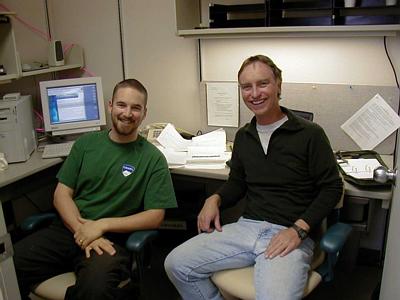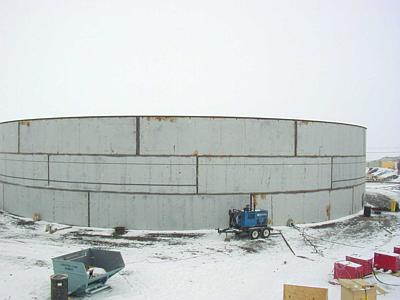24 November, 1999
McMurdo Station, Ross Island, Antarctica
Wednesday
This morning was so clear and beautiful! I wish that I could have gotten
out of town and into the field today!
After such a late night last night, I still had to get up at 6:00 a.m. so
that I could get the gas chromatograph (GC) warmed up for a very long day of
sample analysis! I operated the GC until just after lunch, analyzing the
East Lake Bonney water for the presence of nitrous oxide. I then ran a few
errands (lining up interviews with interesting folk) and went back to the
room for a much needed nap. Unfortunately, I also had to do laundry so I
slept for 30 minutes, moved the laundry to the dryer, slept for 30 minutes,
folded the laundry, and then I took my 2 minute shower. Yes, you heard me
correctly. We are permitted 2 showers a week for 2 minutes each. Now,
there are not any shower police monitoring this activity and violators are
not hauled off to jail! It is, however, in the best interest of the
environment and of McMurdo, if these guidelines are met. I'm afraid that
I've been guilty of breaking this rule on several occassions. I sometimes
shower every other day (especially if it's been a field day) and there have
been a few times when I've let the water run the entire duration of the
shower! I do not let this happen intentionally, I just forget! We are so
used to our creature comforts!
ANSWER TO YESTERDAY'S QUESTION: The coldest temperature ever recorded in
Antarctica was at Russia's Vostok Station (in East Antarctica) on July 21,
1983. The temperature was -89.6 degrees Celsius! What would that be in
Fahrenheit?
TODAY'S QUESTION: What is the 300 Degree Club?
POLAR PROFILE: Today I am going to profile a specific research project and
the two scientists involved. The project is unofficially titled "High
Precision Temperature Measurement At Siple Dome, Antarctica For Paleoclimate
Resconstruction and Ice Dynamics"! WHEW! What a mouthful! It took Gary
Clow and Bob Hawley 2 hours to explain the project to me and I still am
confused on parts of it! I'm only going to whet your appetite and
hopefully, make you want to know more and ask me questions!
In 1998, a team of scientists took a 1000 meter ice core at Siple Dome, near
the top of the dome. The 1000 meter hole left in the ice will be used by
Gary and Bob. They want to understand the dynamics of the West Antarctic
Ice Sheet. In order to understand the ice sheet dynamics, they must first
construct an ice-sheet model, also called a heat transfer model. To do
this, they will measure the geothermal heat flux (how the heat from the
mantle affects the ice), the vertical ice velocity (how the ice is being
compacted), and the horizontal ice velocity (how fast the ice is moving away
from the Dome). The temperature of the ice bore hole will be measured with
a thermistor array, an instrument that, when calibrated will measure
temperatures to 1/10,000th of a degree! That's precise! The horizontal ice
velocity will be measured using Global Positioning Systems (GPS) for ice
moving on the surface. For deeper layers, the horizontal velocity will be
determined by looking at the change in shape of the bore hole. As the deep
ice moves, the bore hole will become distorted. The vertical ice velocity
will be measured using velocity markers. Remember that vertical ice
velocity concerns the rate at which the ice is being pushed downward. Into
the bore hole, they will strategically place "phosphor bronze bands". These
are coiled metal strips, about 3 feet in length, resembling a coffee can
without a top or bottom. They will accurately measure the depth at which
they place the bands using a metal detector. They will also look at the
bands with a camera. Over the next three years, they will monitor the
movement of the bands.
When, after the three year period, they have gathered all of their data,
they will use the model that they produced to predict the paleoclimate of
the ice sheet. The formula involved in solving their problem is somewhere
in the vicinity of 100 pages long! Mr. Baker, they are devising a simpler
problem for your physics students! Visit Bob's website at
www.geophys.washington.edu/People/Students/bo for more information.
Let me tell you a little about the two fellows who are working on this
project. Gary Clow has come to Antarctica 7 times and has spent 6 field
seasons in Greenland, as well. He is a Ph.D. candidate in geophysics at the
University of Utah and has been employed by the United States Geological
Survey for the last 20 years. Gary received his undergraduate degrees in
astrophysics and geophysics from the University of California at Berkeley.
Gary's experience growing up on an almond farm has taught him a great deal
about working with large equipment. This will be a useful skill at Siple
Dome. Can you imagine coming all this way and finding out that your
equipment won't work? Gary has the experience to fix it! He currently
lives in Denver, CO with his wife, Sue.
Bob Hawley has been to Antarctica once previously and has worked on the
Greenland Ice Sheet, spening an entire, dark winter. Bob is also a Ph.D.
candidate studying glaciology in the geophysics program at the University of
Washington in Seattle. His undergrad degree is in geology from the same
institution. Bob is an Emergency Medical Technician (EMT) and a mountaineer
and so, is well suited for his work on the West Antarctic Ice Sheet! Bob
and his wife Suzanne live in Washington.
Sharon
JUST FOR KIDS!!!!! This morning was so clear and beautiful! I wish that I
could have gotten out of town and back to the lake today!
After such a late night last night, I still had to get up at 6:00 a.m. so
that I could get the gas chromatograph (GC) warmed up for a very long day of
sample analysis! I sat at the GC until just after lunch, analyzing the East
Lake Bonney water for the presence of nitrous oxide. I went back to myroom
for a nap! I also had to do laundry so I slept for 30 minutes, moved the
laundry to the dryer, slept for 30 minutes, folded the laundry, and then I
took my 2 minute shower. Yes, you heard me correctly. We are allowed to
take 2 showers a week for 2 minutes each. Now, there are not any shower
police who watches this activity! It takes a lot of work to provide water
to us so we are asked not to waste it! I sure will appreciate my long
showers when I get home!
ANSWER TO YESTERDAY'S QUESTION: The coldest temperature ever recorded in
Antarctica was at Russia's Vostok Station (in East Antarctica) on July 21,
1983. The temperature was -89.6 degrees Celsius! What would that be in
Fahrenheit?
TODAY'S QUESTION: What is the 300 Degree Club?
POLAR PROFILE: I met Bob Hawley and Gary Clow today. They are two
scientists that are going to Siple Dome in West Antarctica to study the
temperature of the West Antarctic Ice Sheet. They are going to use a 1000
meter deep hole left in the ice by other scientists. In three years, they
will have all of their information and, hopefully, will be able to tell what
the climate was like during the last ice age, 22,000 years ago!
Bob and Gary are both very well-suited for their tasks. Bob is studying
glaciology (that is, he likes glaciers) and Gary is studying geophysics.
Bob is also an Emergency Medical Technician and a mountaineer. Gary grew up
on an almond farm and knows how to repair their equipment. Now if one of
them could just cook a good meal!
Sharon

Bob Hawley and Gary Clow, two scientists heading for Siple Dome to study the temperature of the West Antarctic Ice Sheet.

An exterior view of the diesel fuel tanks that I wrote about yesterday.

John Bray grinding a weld. John very politely told me that the term "sanding" applied to wood!

Steve, the essential crane operator! Note the concentration on Steve's face as he follows the hand signals from welders positioned on the roof!
Contact the TEA in the field at
.
If you cannot connect through your browser, copy the
TEA's e-mail address in the "To:" line of
your favorite e-mail package.
|
